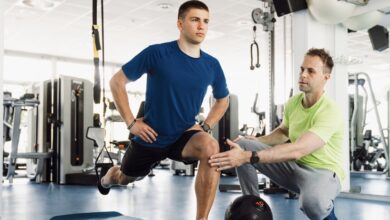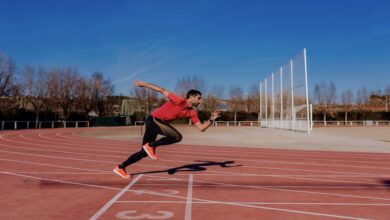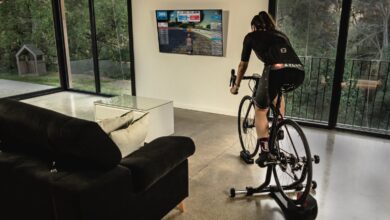Calculate maximum heart rate and training zones

La maximum heart rate is the highest number of beats per minute that your heart can pump under a situation of maxim Pressure. This value is very useful when you want to improve your training levels.
But first you have to know some concepts, before entering into the topic of calculating the training areas and the ways to do it.
Heart rate
La heart rate, or HR, is the number of beats the heart reaches in one minute. It is expressed in beats per minute (bpm) or beats per minute (bpm).
When we talk about maximum heart rate we now understand what it means to "beats under maxim pressure ”: these are the maximum beats that your heart can give without collapsing.

So the heart rate It is the beats that the heart makes to maintain basal metabolism, and the best time to take your pulse and know what your frequency basal is when you wake up in the morning.
All you have to do is locate the radial artery in the left wrist with your index and middle fingers of the right hand –which is 2 cm below the base of the thumb–, time 10 or 15 seconds and count your pulsations.
If you do it in 10 seconds, you must multiply the number of beats by 6, and if you do it by 15, multiply by 4. With this, you will know what your heart rate Resting.
But we are interested in knowing what the maximum heart rate, because in this way we will know what the training capacity is and we will not expose the heart to a greater effort than it can bear, and in this way we guarantee maximum aerobic work.
La maximum heart rate It varies from person to person, and depends on various factors: gender, age, if it is hot, if the person is hydrated and if they are an athlete or sedentary, among many others.
You should know that the maximum heart rate It will not be the same for a person without physical activity as for another who trains daily. The latter will have it lower.
How to calculate maximum heart rate (HRMax)
There is a “home” test to measure HRMax, called the “Fox and Haskell formula”, and it consists of subtracting your age from 220. It has a certain margin of error, but it is useful to start training.
For example, if you are 32 years old and you are a man, you should do the following:
220-32: 188 ppm.
If you are a woman (it is common for women to have a heart rate higher), you have to subtract your age from 225. For example:
225-28: 197 ppm.
Since this formula presents errors because discrepant values were detected with the real ones, studies have been carried out to measure the maximum heart rate, although experts recommend doing a stress test with cardiologists, on a stationary bike and on a treadmill. It is the most accurate way.
These other studies, like the one by Tanaka, present a slightly more reliable formula: 208 - (0.7 x age). For the same example of the 32-year-old man, his HRMax will be 208 - (22.4) = 185.6 bpm.
And for women it would be the Gulati formula: 206 - (0.88 x age). Taking the previous example in a 28-year-old woman, it would be: 206 - (24.64) = 181.3 ppm. We should mention that these formulas also have a margin of error.
Calculate HRMax with a field test
Another way, much more precise, is to do a field test. To do this, you must warm up the body before doing the test, and no laboratory equipment is necessary, your monitor will suffice. heart rate.
After the warm-up, you will do an activity that requires your maximum effort. Ideally, you should prepare two weeks in advance by exercising at least 5 days a week.
Example of a field test for sedentary people who want to start practicing sports
It is a good idea to have a partner supervise you. You will have to write down the heart rate higher you reach, which will be your HRMax.
Heating: walk 10 minutes at a comfortable pace.
Test: 500 meters or 100 stairs.
Procedure: on a slight slope, go up and increase your speed progressively until you reach the maximum you can hold. Check the monitor and write down the value that appears, which will be an approximate to your maximum heart rate.
Cooling: walk again for 10 minutes, the same as in the warm-up.
Sample test for people who want to resume a sports practice
Heating: run 15 minutes at a comfortable pace.
Test: 1.000 meters.
Procedure: on flat ground, start running after warming up, progressively increasing speed until reaching maximum effort. Check the monitor and write down the value.
Cooling- Lower your running intensity with 10 minutes of comfortable jogging.
Test example for athletes (for running and running)
Heating: run 20 minutes at a comfortable pace.
Test: 3.000 meters.
Procedure: on flat and unobstructed terrain, cover 3.000 meters in the shortest time possible. Check the monitor and write down the value.
Cooling: Return to a comfortable jog for 20 minutes.
Test example for cyclists
Heating: With high cadence and smooth development, get going and pedal for 5 to 10 minutes.
Test: rise.
Procedure: do a sprint and on the uphill pedal with high pulsations (about 150), increase the speed progressively until you reach the end of the climb with your maximum effort. Check the monitor and write down.
Cooling: go down at a comfortable pace and pedal for 5 minutes.
Heart rate zones
There are 5 training zones, let's see them in a table:
| 1 ZONE
VERY LIGHT |
2 ZONE
LIGHTWEIGHT |
ZONE 3 MODERATE | ZONE 4 STRONG | ZONE 5 MAXIMUM EFFORT |
| Warm-ups, rehabilitation, initial aerobic | Comfortable pace, basic cardio training (you can talk quietly) | It does a good job at the cardiovascular level. Breathing is heavy and it is more difficult to speak | It is the anaerobic threshold. The intensity is much higher to improve performance. Breathing is forced | This is the intensity that can be endured. Anaerobic resistance is worked on and cannot be maintained for long periods of time |
| 50 - 60% with 104-114 ppm | 60 - 70% with 114-133 ppm | 70 - 80% with 133-152 ppm | 80 - 90% with 152-172 ppm | 90 - 100% with 172-190 ppm |
| 20-40 minutes | 40-80 minutes | 10-40 minutes | 2-10 minutes | less than 5 minutes |
With this table you will already know how long you can reach your maximum heart rate depending on the training zone you are in.
Good breathing will help improve performance, especially when you're at your best.
Karvonen formula
This formula is used to calculate the HRMax according to the training zone. It is as follows:
% of Target HR = ((HRMax - Fcrep) x% intensity) + HRrep.
If you want to know, for example, the optimal pulsations for an intensity of 80%, let's use the data of the 32-year-old man, whose HRMax is - following the Tanaka formula - 188 ppm, and with HRrep of 46 ppm.
FC at 80% = ((188-46) x 0.8) + 46 = 159.6 ppm.
You can do the same for the rest of the intensities, and thus you will have your complete table of the pulse training zones.
There are no previous results.




























